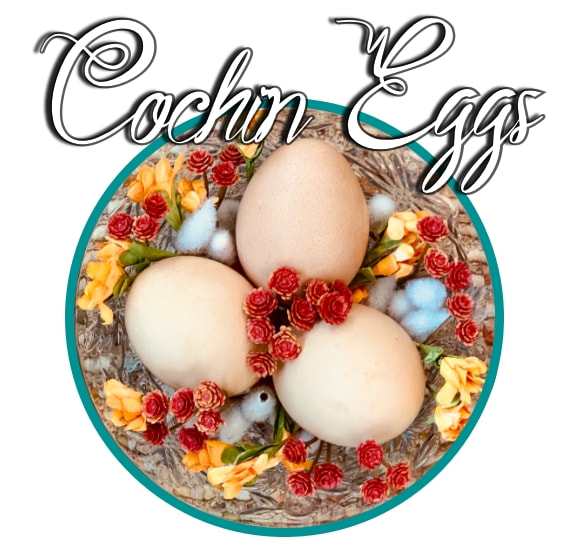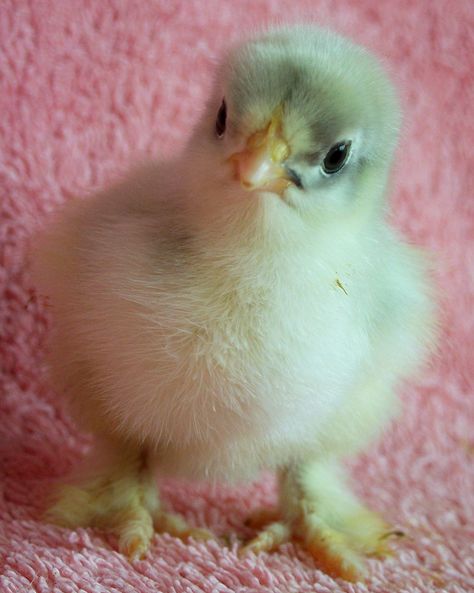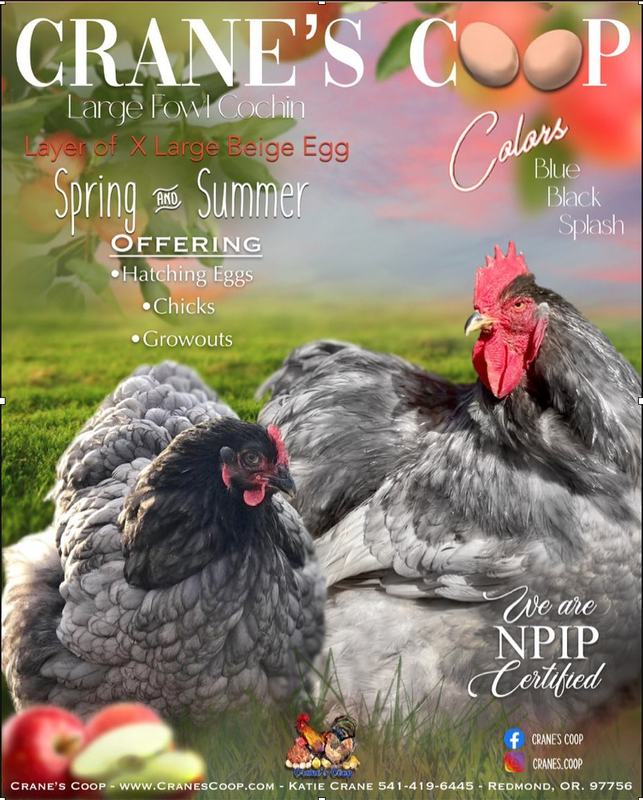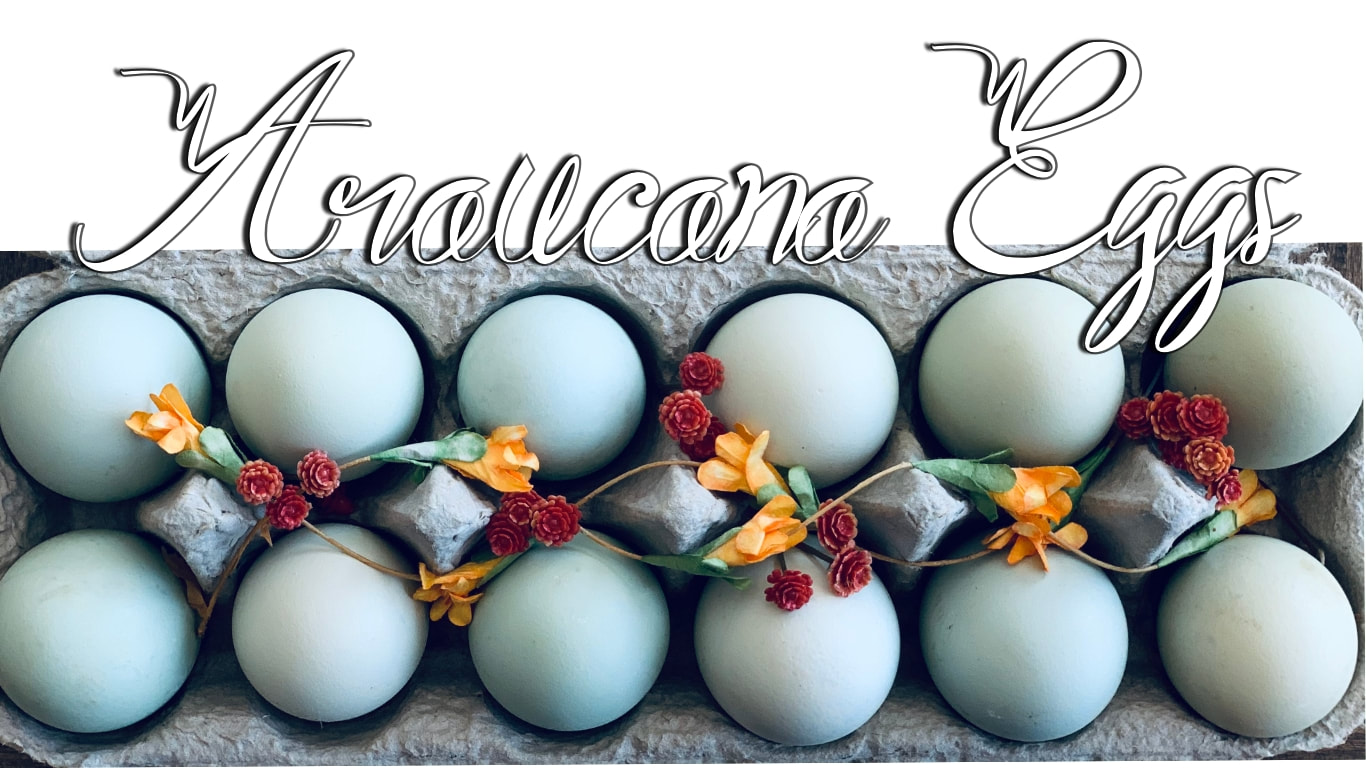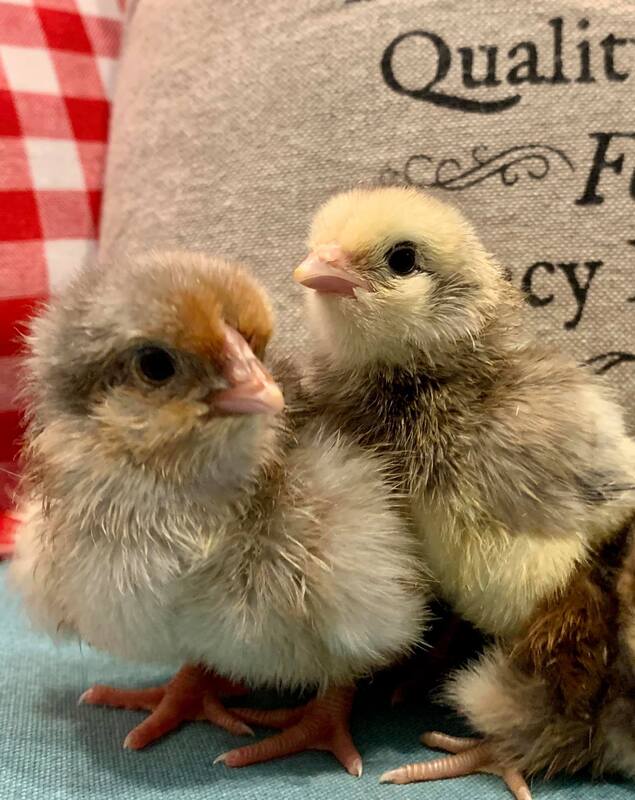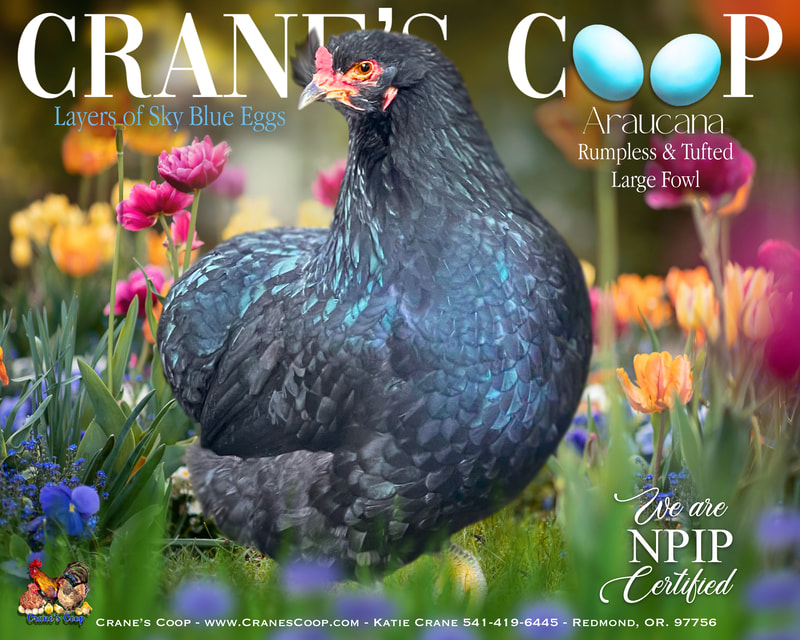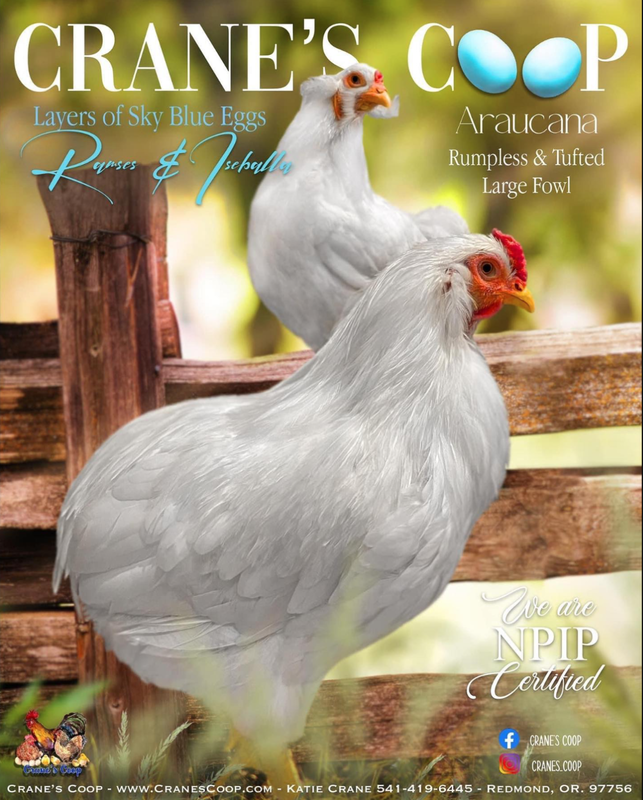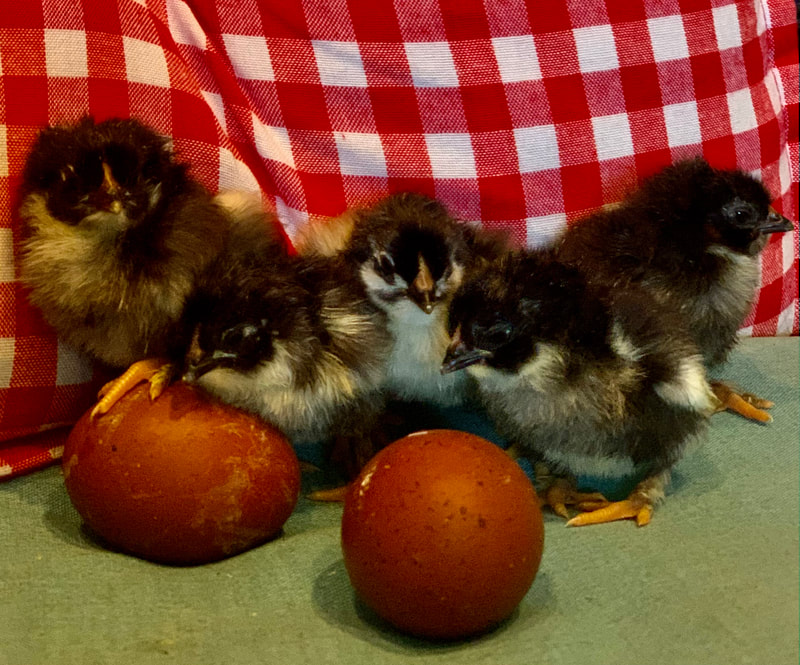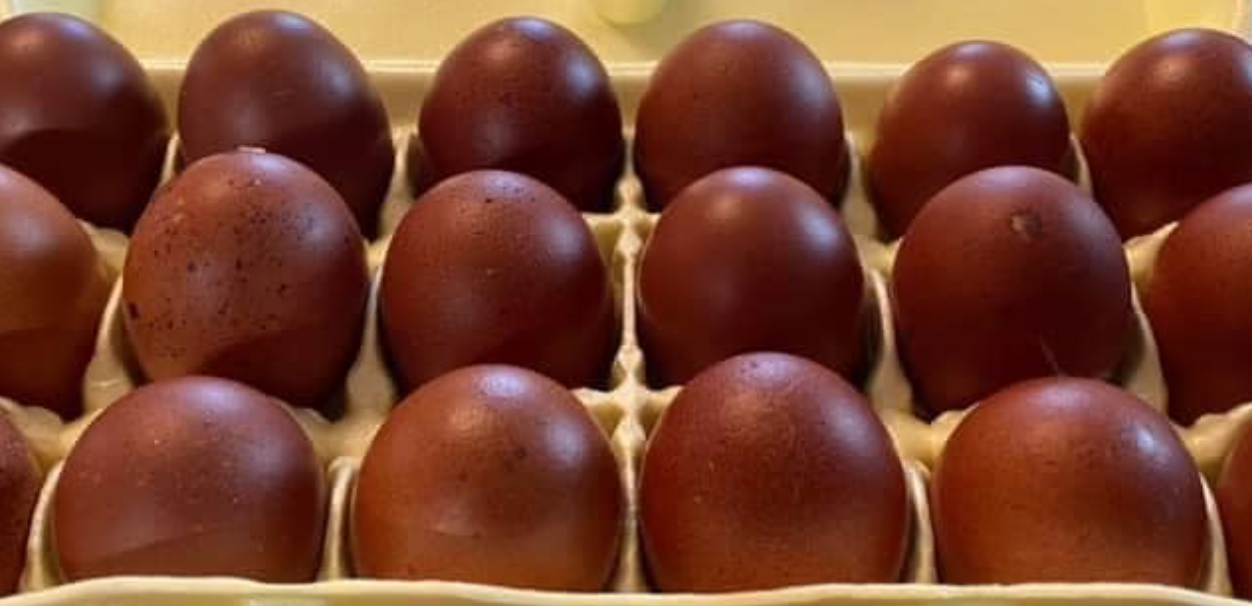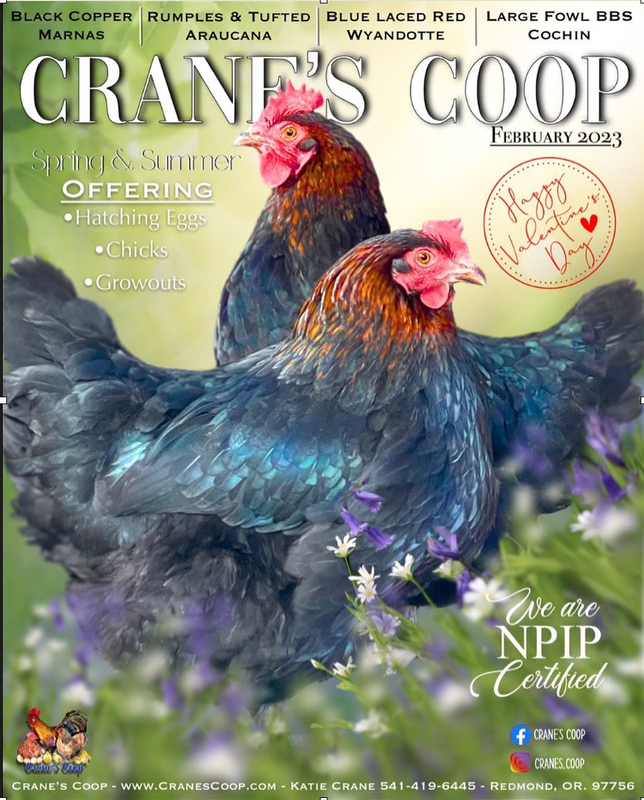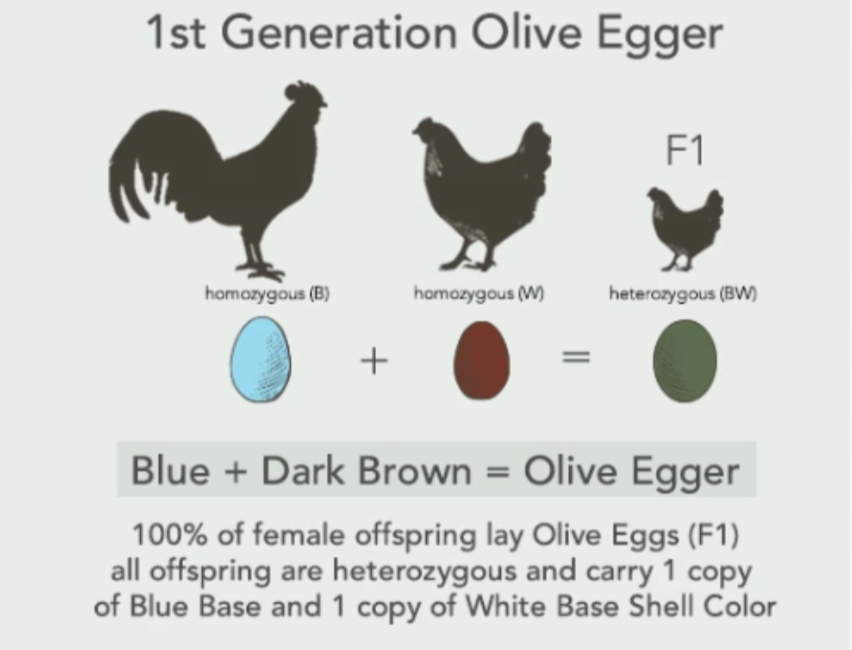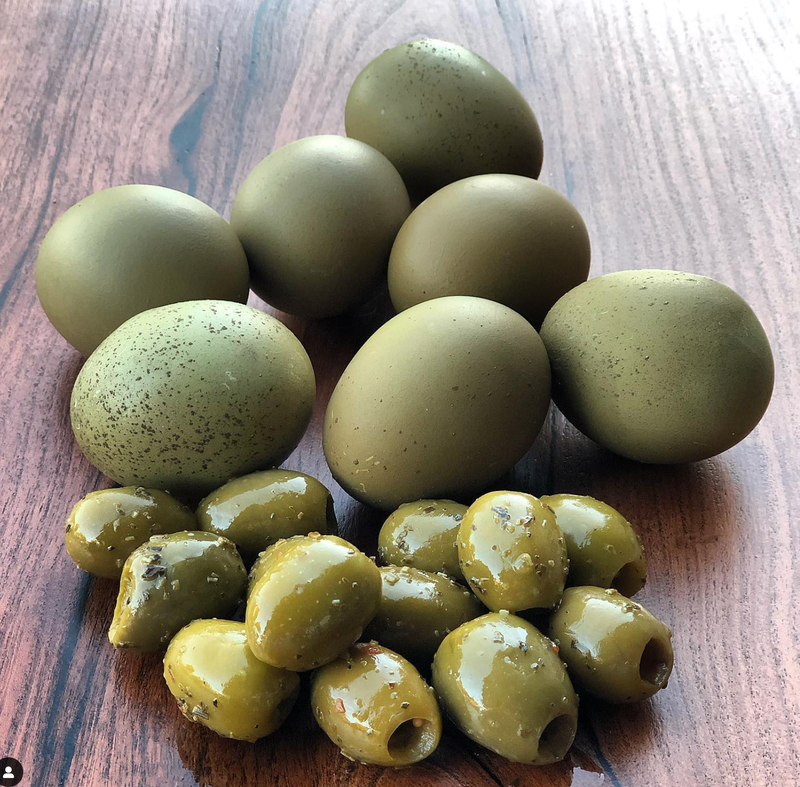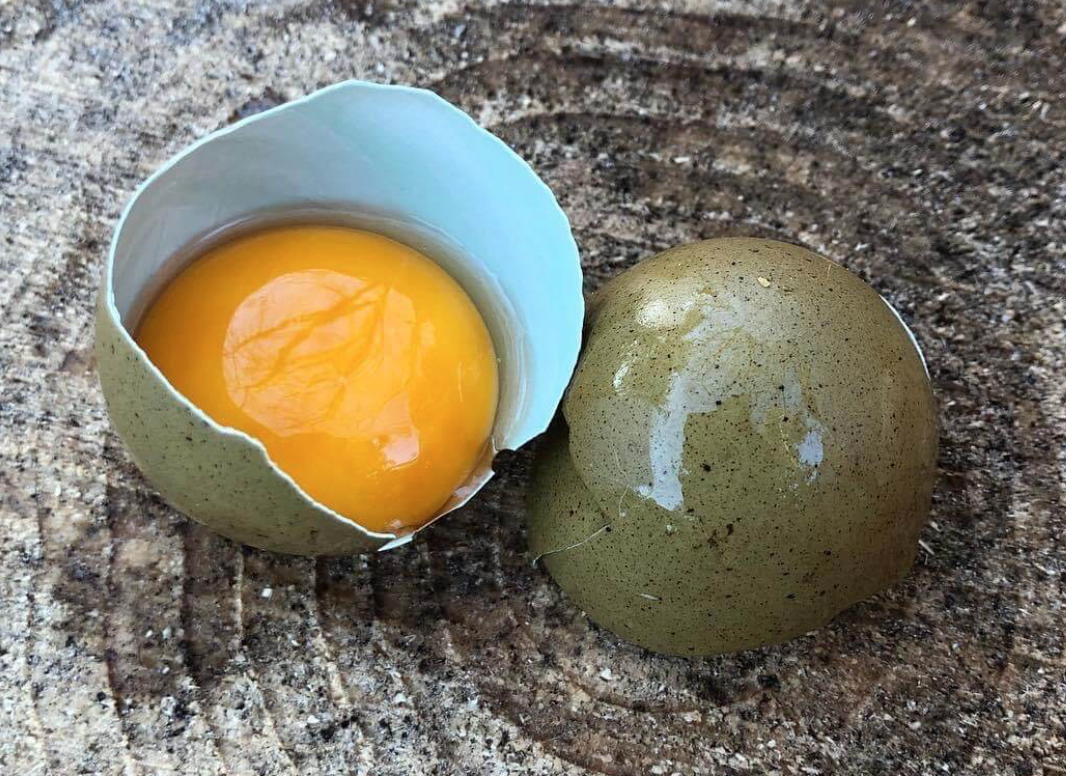Crane's Coop Chicks
We start to hatch out late February through October. Chicks are available for local pick up. We do travel over to the Willamette Valley often as we have friends and Family in the Salem/Dallas area. If we're headed that way we can arrange to bring your chicks over to you. We make sure our chicks are healthy and strong for their arrival to their new home. After chicks leave our facility they are now in your care so we cannot guarantee anything once they leave our care. We feed our chicks high protein chick starter with chick grit and clean water with added electrolytes. After chicks hatch out we place our chicks in our GQF battery brooder so they have more room and can start to enjoy the life of a chick. Our facility is NPIP tested and clean!
Large Fowl Cochins
The Cochin is a breed of large domestic chicken. It derives from large feather-legged chickens brought from China to Europe and North America in the 1840s and 1850s. It is reared principally for exhibition. It was formerly known as Cochin-China.
HistoryLike the Brahma, the Cochin derives from very large feather-legged chickens brought from China to Europe and North America in the 1840s and 1850s. These were at first known as "Shanghai" birds, and later as "Cochin-Chinas".The large size and striking appearance of these birds contributed to a sudden large increase of interest in poultry-breeding in Western countries, sometimes described as "hen fever".
The Cochin was included in the first edition of the Standard of Excellence in Exhibition Poultry, prepared by William Bernhardt Tegetmeier for the first Poultry Club of Great Britain in 1865. The colors described are buff, black, cinnamon, grouse, lemon, partridge, silver buff, silver cinnamon, and white.
The Cochin, both full-sized and bantam, was included in the first edition of the Standard of Excellence of the American Poultry Association in 1874.The original colors were white, partridge, buff and black; other colors were later added.
CharacteristicsThe most distinctive feature of the Cochin is the excessive plumage that covers leg and foot. The skin beneath the feathers is yellow.
In the United Kingdom the recognised colour varieties, for large fowl only, are black, blue, buff, cuckoo, partridge and grouse, and white; Cochin bantams are not recognised by the Poultry Club of Great Britain. The Entente Européenne lists the same nine colours for full-sized Cochins, and twenty-four for the bantam; any of the bantam varieties may be frizzled, with the feathers curling outwards. The American Poultry Association recognises nine colours for the full-sized bird – barred, black, blue, brown, buff, golden-laced, partridge, silver-laced, and white; the same colours are recognised for the bantam, with the addition of four more: birchen, Columbian, mottled, and red.
UseThe Cochin has been bred principally for exhibition, at the expense of productive characteristics. It is a good layer of very large tinted eggs, and lays well in winter.The hens are good sitters and good mothers, and may be used to hatch the eggs of turkeys and ducks.The meat tends to be coarse in texture and excessively dark; slaughtered at an age of 12–16 months provide a good large table bird.
Araucana
The Araucana (Spanish: Gallina Mapuche) is a breed of domestic chicken from Chile. Its name derives from the Araucanía region of Chile where it is believed to have originated. It lays blue-shelled eggs, one of very few breeds that do so.
Breed standards for the Araucana vary from country to country. It may have unusual tufts of feathers on the ears, and may be rumpless, without a tail and tail-bone; in the United States it may for this reason be known as the South American Rumpless. Both ear-tufts and rumplessness are caused by lethal genes, so not all birds display these traits. The Ameraucana breed and "Easter egger" hybrids of the United States, which also lay blue or green eggs, both derive from the Araucana.
HistoryThe early history of the Araucana is not documented. The birds were commonly seen in South America in the early twentieth century.The Spanish aviculturist Salvador Castelló, who visited Chile in 1914, saw them and named them "Gallina Araucana", as many were found among the Mapuche people of the Araucanía region of Chile, whom the Spanish called Araucanos. Castelló believed the birds to belong to a new species, and reported his observations at the First World's Poultry Congress in The Hague in 1921. The systematic name Gallus inauris was proposed for them, and adopted at the Second World's Poultry Congress in Barcelona in 1924. It was later established that the Araucana belongs to the same species as other domestic chickens.
The blue egg of the Araucana was at this time thought to be unique among chickens. In 1933 Reginald Punnett showed that the blue egg ("oocyan") gene in chickens is dominant with respect to white, while in combination with genes for brown eggs, various shades of green and olive are produced. In modern times, the Ameraucana breed, a derivative of the Araucana, also lays blue eggs, while hybrid birds carrying the dominant oocyan gene may in the United States be called "Easter eggers".
Several theories have been advanced to explain the origin of the blue egg characteristic. It has been variously attributed to hybridisation with Tinamus solitarius, a species of tinamou (dismissed as "erroneous" by Helmut Sick to genetic mutation and to the action of a retrovirus soon after the domestication of the chicken.
Blue Araucana eggs were taken to Australia from New Zealand in the 1930s. The breed was standardised in the 1980s.
Blue-egg chickens from South America were introduced to the British Isles at various times in the early twentieth century. The modern British-type Araucana derives from birds from a Chilean ship that was wrecked in the Hebrides.The British Araucana was developed mainly by George Malcolm in Scotland in the 1930s. He introduced the Lavender plumage variety, and bred the bantam Araucana in the 1940s. The British-type Araucana was standardised in 1969 or 1974.
In the United States, two breeds were established: the Araucana, which has ear-tufts and is rumpless, was standardised in 1976, and the Ameraucana, which is bearded, muffed and tailed (and thus similar to the tailed British type), was added to the Standard of Perfection in 1984.
There has been a long and inconclusive debate about the origin of the Araucana and whether it derives from chickens brought by Europeans after Columbus reached the Americas in 1492, or if it was already present. A report published in 2007 on chicken bones found on the Arauco Peninsula in south-central Chile suggested pre-Columbian, possibly Polynesian, origin. A report published in 2008 found no evidence of pre-Columbian introduction from Polynesia.
The world-wide conservation status of the Araucana is "not at risk";population data for Chile is not reported.
CharacteristicsThere are both full-sized and bantam Araucanas. They may be either normally tailed or rumpless. The Araucana has a pea comb and lays approximately 250 blue or green eggs per year.
In Australia, only the tailed Araucana is recognised in the Australian Poultry Standards, both tailed and rumpless may be exhibited.
The British standard accepts both tailed and rumpless, they may be treated as separate breeds. The British type of Araucana has a beard and muffs which conceal the earlobes.
In North America, Araucanas have long ear-tufts and are rumpless. As both ear-tufts and rumplessness are caused by autosomal dominant lethal alleles, not all of the birds can display these traits.
A total of twenty plumage varieties are listed for the Araucana by the Entente Européenne d’Aviculture et de Cuniculture. Of these, five are recognised by the American Poultry Association for large fowl: black, black breasted red, silver duckwing, golden duckwing, and white; for bantams, buff is added to these. The Australian Poultry Standard recognises black, cuckoo, lavender, splash, white and any colour which is standard in Old English Game. The Poultry Club of Great Britain recognises twelve colours: black, black-red, blue, blue-red, crele, cuckoo, golden duckwing, lavender, pile, silver duckwing, spangled, and white.
Egg LayingSince Araucanas are on the smaller side, they are not ideal as a meat bird, but what they lack in meat, they make up for in beautiful blue eggs. Even though hens are on the smaller size, their eggs are medium-sized and perfect for your Easter basket, and hey, you don’t even have to color them! At a rate of approximately 3 eggs per week, the Araucana is not necessarily meant for production, but she can certainly earn her keep. However, because this plucky hen originated in the warmer climates of South America, she does tend to take the winters off from laying. No matter, she will be back at it once the weather warms up and just in time for Spring egg hunts with the kids.
TemperamentThe jury is out on the temperament of the Araucana. Some enthusiasts say they are the friendliest chickens they’ve ever owned, while others swear that they are flighty and nervous. High energy may not always equate to unfriendly chickens, so it might just depend on who you talk to and how they chose to interact with their Araucanas.
A quick internet search will reveal that those who have dedicated themselves to developing this breed have only loving interactions with their Araucanas. Many breeders will tell you that they are great chickens for the kids because they actually enjoy being cuddled and handled.
BroodinessAraucana hens tend to go broody frequently, and easily. This means they just happen to enjoy raising their own little clutch of chicks, and if you plan to breed these birds, leaving the mother hen to do her job will make the process easier for you. Just remember that the hatch rate is pretty low for the Araucana, so don’t be discouraged if only a few babies hatch.
And on that note, if momma hen has been broody for a long time, is losing weight, and looking a little rough, it may be time to help her move on from any eggs that have not hatched.
HardinessThe Araucana is surprisingly hardy during the winter. Even though these chickens originated in warmer climates, they do particularly well in the cold. Having a pea comb makes frostbite uncommon.
In the same line, Araucanas can handle the hot weather just as easily. They are adaptive chickens that really seem to go with the flow, no matter where they live.
Free-RangeAraucanas are particularly curious and active chickens, and they love to spend their days scratching about for tasty treats. They are savvy chickens, who keep their eyes peeled for predators and do their best to stay out of harm’s way.
It’s been noted that Araucanas tend to travel a bit more than a typical chicken, and they enjoy taking the same route on a daily basis. So, if your neighbors aren’t in love with chickens, make sure you keep your chickens in a fenced yard because once they figure out where the good stuff is, they will keep going back for more!
Araucanas are a special breed that are highly sought after due to their bright blue eggs and fun characteristics. While Easter Eggers, and Ameraucanas, also lay colorful eggs, it is the Araucana that consistently produces those beautiful robins-egg blue eggs. If their lovely eggs don’t have you sold on the breed, their comical physical appearance certainly will. Who doesn’t love a little personality in their flock?
Breed standards for the Araucana vary from country to country. It may have unusual tufts of feathers on the ears, and may be rumpless, without a tail and tail-bone; in the United States it may for this reason be known as the South American Rumpless. Both ear-tufts and rumplessness are caused by lethal genes, so not all birds display these traits. The Ameraucana breed and "Easter egger" hybrids of the United States, which also lay blue or green eggs, both derive from the Araucana.
HistoryThe early history of the Araucana is not documented. The birds were commonly seen in South America in the early twentieth century.The Spanish aviculturist Salvador Castelló, who visited Chile in 1914, saw them and named them "Gallina Araucana", as many were found among the Mapuche people of the Araucanía region of Chile, whom the Spanish called Araucanos. Castelló believed the birds to belong to a new species, and reported his observations at the First World's Poultry Congress in The Hague in 1921. The systematic name Gallus inauris was proposed for them, and adopted at the Second World's Poultry Congress in Barcelona in 1924. It was later established that the Araucana belongs to the same species as other domestic chickens.
The blue egg of the Araucana was at this time thought to be unique among chickens. In 1933 Reginald Punnett showed that the blue egg ("oocyan") gene in chickens is dominant with respect to white, while in combination with genes for brown eggs, various shades of green and olive are produced. In modern times, the Ameraucana breed, a derivative of the Araucana, also lays blue eggs, while hybrid birds carrying the dominant oocyan gene may in the United States be called "Easter eggers".
Several theories have been advanced to explain the origin of the blue egg characteristic. It has been variously attributed to hybridisation with Tinamus solitarius, a species of tinamou (dismissed as "erroneous" by Helmut Sick to genetic mutation and to the action of a retrovirus soon after the domestication of the chicken.
Blue Araucana eggs were taken to Australia from New Zealand in the 1930s. The breed was standardised in the 1980s.
Blue-egg chickens from South America were introduced to the British Isles at various times in the early twentieth century. The modern British-type Araucana derives from birds from a Chilean ship that was wrecked in the Hebrides.The British Araucana was developed mainly by George Malcolm in Scotland in the 1930s. He introduced the Lavender plumage variety, and bred the bantam Araucana in the 1940s. The British-type Araucana was standardised in 1969 or 1974.
In the United States, two breeds were established: the Araucana, which has ear-tufts and is rumpless, was standardised in 1976, and the Ameraucana, which is bearded, muffed and tailed (and thus similar to the tailed British type), was added to the Standard of Perfection in 1984.
There has been a long and inconclusive debate about the origin of the Araucana and whether it derives from chickens brought by Europeans after Columbus reached the Americas in 1492, or if it was already present. A report published in 2007 on chicken bones found on the Arauco Peninsula in south-central Chile suggested pre-Columbian, possibly Polynesian, origin. A report published in 2008 found no evidence of pre-Columbian introduction from Polynesia.
The world-wide conservation status of the Araucana is "not at risk";population data for Chile is not reported.
CharacteristicsThere are both full-sized and bantam Araucanas. They may be either normally tailed or rumpless. The Araucana has a pea comb and lays approximately 250 blue or green eggs per year.
In Australia, only the tailed Araucana is recognised in the Australian Poultry Standards, both tailed and rumpless may be exhibited.
The British standard accepts both tailed and rumpless, they may be treated as separate breeds. The British type of Araucana has a beard and muffs which conceal the earlobes.
In North America, Araucanas have long ear-tufts and are rumpless. As both ear-tufts and rumplessness are caused by autosomal dominant lethal alleles, not all of the birds can display these traits.
A total of twenty plumage varieties are listed for the Araucana by the Entente Européenne d’Aviculture et de Cuniculture. Of these, five are recognised by the American Poultry Association for large fowl: black, black breasted red, silver duckwing, golden duckwing, and white; for bantams, buff is added to these. The Australian Poultry Standard recognises black, cuckoo, lavender, splash, white and any colour which is standard in Old English Game. The Poultry Club of Great Britain recognises twelve colours: black, black-red, blue, blue-red, crele, cuckoo, golden duckwing, lavender, pile, silver duckwing, spangled, and white.
Egg LayingSince Araucanas are on the smaller side, they are not ideal as a meat bird, but what they lack in meat, they make up for in beautiful blue eggs. Even though hens are on the smaller size, their eggs are medium-sized and perfect for your Easter basket, and hey, you don’t even have to color them! At a rate of approximately 3 eggs per week, the Araucana is not necessarily meant for production, but she can certainly earn her keep. However, because this plucky hen originated in the warmer climates of South America, she does tend to take the winters off from laying. No matter, she will be back at it once the weather warms up and just in time for Spring egg hunts with the kids.
TemperamentThe jury is out on the temperament of the Araucana. Some enthusiasts say they are the friendliest chickens they’ve ever owned, while others swear that they are flighty and nervous. High energy may not always equate to unfriendly chickens, so it might just depend on who you talk to and how they chose to interact with their Araucanas.
A quick internet search will reveal that those who have dedicated themselves to developing this breed have only loving interactions with their Araucanas. Many breeders will tell you that they are great chickens for the kids because they actually enjoy being cuddled and handled.
BroodinessAraucana hens tend to go broody frequently, and easily. This means they just happen to enjoy raising their own little clutch of chicks, and if you plan to breed these birds, leaving the mother hen to do her job will make the process easier for you. Just remember that the hatch rate is pretty low for the Araucana, so don’t be discouraged if only a few babies hatch.
And on that note, if momma hen has been broody for a long time, is losing weight, and looking a little rough, it may be time to help her move on from any eggs that have not hatched.
HardinessThe Araucana is surprisingly hardy during the winter. Even though these chickens originated in warmer climates, they do particularly well in the cold. Having a pea comb makes frostbite uncommon.
In the same line, Araucanas can handle the hot weather just as easily. They are adaptive chickens that really seem to go with the flow, no matter where they live.
Free-RangeAraucanas are particularly curious and active chickens, and they love to spend their days scratching about for tasty treats. They are savvy chickens, who keep their eyes peeled for predators and do their best to stay out of harm’s way.
It’s been noted that Araucanas tend to travel a bit more than a typical chicken, and they enjoy taking the same route on a daily basis. So, if your neighbors aren’t in love with chickens, make sure you keep your chickens in a fenced yard because once they figure out where the good stuff is, they will keep going back for more!
Araucanas are a special breed that are highly sought after due to their bright blue eggs and fun characteristics. While Easter Eggers, and Ameraucanas, also lay colorful eggs, it is the Araucana that consistently produces those beautiful robins-egg blue eggs. If their lovely eggs don’t have you sold on the breed, their comical physical appearance certainly will. Who doesn’t love a little personality in their flock?
Black Copper Marans
French Black Copper Marans are the quintessential dark egg layer. They are broad, stand tall and just as their name suggests – black and copper. They are fair layers of medium-large eggs ranging in color from caramel to chocolate. ... 🥚 Black Copper Maransproduce 175-200 medium to large dark brown eggs per year.
We are really excited about our Marans for the 2021 breeding program. After years of tinkering we believe we have finally found the perfect balance of stunning dark chocolate egg color, high production and hen beauty. The marans egg is always the egg that will stop people in their tracks when they look at a dozen. The color and quality of the eggs that our marans lay is one of the many things that makes our breeding program stand out in comparison to larger hatcheries. You will not be disappointed by the beauty of both the birds and eggs of this breed.
Our girls and boys are all feathered on shank and their outside toes. 90% of our females have nice copper expression in their necks and all have an excellent disposition. Our Cranes Coop Lines of French Black Copper Marans are a mix of Vicki B., LP, and Green Fire Farms. Look for our lines from Steve C. next breeding season!
We are particularly fond of our Marans roosters who are not only stunning, they are extremely docile and trustworthy. Our roosters faithfully mate with our hens and always give them the first chance at food.
Whenever we sell a dozen mixed rainbow eggs to a customer they always comment on the Marans eggs first because of their beauty and size. The quality of their egg overall is superior to that of a regular hen. The shells are thick and hard and when cracked open, the yolk of our free-range birds is bright orange, bursting with vitamins, protein and fats from the extra time it took to lay the egg. While a typical store-bought egg has a yolk that is runny and flaccid, the free-range Marans produce yolks that have ‘muscle tone;’ little orange domes that just skyward from the egg white.
We are really excited about our Marans for the 2021 breeding program. After years of tinkering we believe we have finally found the perfect balance of stunning dark chocolate egg color, high production and hen beauty. The marans egg is always the egg that will stop people in their tracks when they look at a dozen. The color and quality of the eggs that our marans lay is one of the many things that makes our breeding program stand out in comparison to larger hatcheries. You will not be disappointed by the beauty of both the birds and eggs of this breed.
Our girls and boys are all feathered on shank and their outside toes. 90% of our females have nice copper expression in their necks and all have an excellent disposition. Our Cranes Coop Lines of French Black Copper Marans are a mix of Vicki B., LP, and Green Fire Farms. Look for our lines from Steve C. next breeding season!
We are particularly fond of our Marans roosters who are not only stunning, they are extremely docile and trustworthy. Our roosters faithfully mate with our hens and always give them the first chance at food.
Whenever we sell a dozen mixed rainbow eggs to a customer they always comment on the Marans eggs first because of their beauty and size. The quality of their egg overall is superior to that of a regular hen. The shells are thick and hard and when cracked open, the yolk of our free-range birds is bright orange, bursting with vitamins, protein and fats from the extra time it took to lay the egg. While a typical store-bought egg has a yolk that is runny and flaccid, the free-range Marans produce yolks that have ‘muscle tone;’ little orange domes that just skyward from the egg white.
F-1 Olive Eggers
We have crossed our Black Araucana Rooster (Professor Snape) with two of our Black Copper Marans Dark Chocolate Egg layers, to make F-1 Olive Eggers Hatching Eggs.
Olive Eggers lay eggs that are shades of olive green, ranging from lighter blue-green to a rich dark olive.
Here's a more detailed breakdown:
Olive Eggers lay eggs that are shades of olive green, ranging from lighter blue-green to a rich dark olive.
Here's a more detailed breakdown:
- Hybrid Breed:
Olive Eggers are a hybrid breed created by crossing chickens that lay blue eggs (like Araucana's) with those that lay brown eggs (like Marans or Welsummers). - Egg Color:
The resulting eggs are a beautiful olive-green color, a combination of the blue and brown egg-laying genes. - Variations:
The shade of green can vary, from lighter, more muted greens to deeper, more vibrant olives, depending on the individual chicken's genetics. - Not an Official Breed:
While Olive Eggers are popular for their unique egg color, they are not recognized as an official breed by the American Poultry Association. - F1 vs F2:
First generation Olive Eggers (F1) are the result of the initial cross, and second generation Olive Eggers (F2) are the result of breeding two F1 Olive Eggers. F2 Olive Eggers may lay a wider variety of colors, including brown, tan, blue, white, and even pink eggs.
Site Designed & Managed by: Crane's Coop


